[Ad-Oracle-Sql] 1. Sequence
Categories: Ad-Oracle-Sql
Tags: Sequence
📋 This is my note-taking from what I learned in the class “Advanced Database Concepts”
Objective
- Define the purpose of a sequence and state how it can be used in a database
- Explain why gaps may appear in the integers generated by a sequence
- Use the CREATE SEQUENCE command to create a sequence
- Call and use sequence values
- Identify which options cannot be changed by the ALTER SEQUENCE command
- Delete a sequence
- Create indexes with the CREATE INDEX command
- Explain the main index structures: B-tree and bitmap
- Verify index use with the explain plan
- Introduce variations on conventional indexes, including a function-based index and an index organized table
- Verify index existence via the data dictionary
- Rename an index with the ALTER INDEX command
- Remove an index using the DELETE INDEX command
- Create and remove a public synonym
Database Objects
-
- An object is anything that has a name and defined structure
-
- Table: Stores data
-
- Sequence: Generates sequential integers
-
- Index: Allows users to quickly locate specific records
-
- Synonym: Alias for other database objects
Sequences
- Used for internal control purposes by providing sequential integers for auditing
-
- Used to generate unique value for primary key column
- Surrogate key = No correlation with actual row contents
Creating a Sequence
- Use the
CREATE SEQUENCEcommand -
- Various intervals are allowed
- Default: 1
-
- You can specify the starting number
- Default: 1
CREATE SEQUENCE sequencename
[INCREMENT BY value]
[START WITH value]
[{MAXVALUE value | NOMAXVALUE}]
[{MINVALUE value | NOMINVALUE}]
[{CYCLE | NOCYCLE}]
[{ORDER | NOORDER}]
[{CACHE value | NOCACHE}];
- Can specify
MINVALUEfor decreasing sequence andMAXVALUEfor increasing sequence - Numbers can be reused if
CYCLEis specified -
ORDERclause is used in application cluster environment- The order clause guarantees that the sequence’s next value is the next one in line, no matter the instance that received the request
- Use
CACHEto pregenerate integers - Default: 20
CREATE SEQUENCE orders_order#_seq
INCREMENT BY 1
START WITH 1021
NOCACHE
NOCYCLE;
-- CREATE SEQUENCE succeeded
- To verify the settings for options of a sequence, query
USER_SEQUENCESdata dictionary view
SELECT * FROM user_sequences;
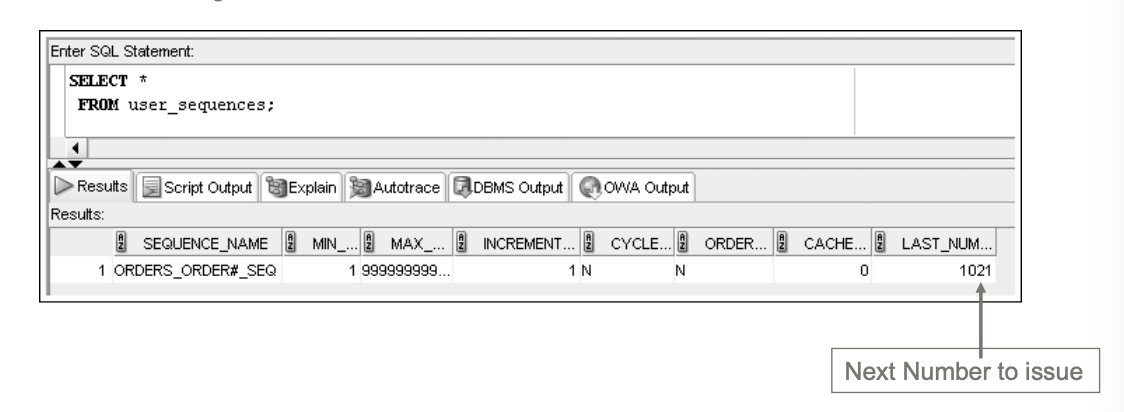
Using Sequence Values
NEXTVAL- Generates integer
INSERT INTO orders (order#, customer#, orderdate, shipdate, shipstreet, shipcity, shipstate, shipzip)
VALUES (orders_order#_seq.NEXTVAL, 1010, '06-APR-09', NULL, '123 WEST MAIN', 'ATLANTA', 'GA', 30418);
-- 1 rows inserted
CURRVAL- Contains last integer generated byNEXTVAL
INSERT INTO orders (order#, customer#, orderdate, shipdate, shipstreet, shipcity, shipstate, shipzip)
VALUES (orders_order#_seq.CURRVAL, 1010, '06-APR-09', NULL, '123 WEST MAIN', 'ATLANTA', 'GA', 30418);
-- 1 rows inserted
- Set Column
DEFAULTvalue
CREATE SEQUENCE test_defval_seq
INCREMENT BY 1
START WITH 100
NOCACHE
NOCYCLE;
CREATE TABLE test_defval
(col1 NUMBER DEFAULT test_defval_seq.NEXTVAL,
col2 NUMBER);
-- sequence TEST_DEFVAL_SEQ created.
-- table TEST_DEFVAL created.
Altering Sequence Definitions
- Use
ALTER SEQUENCEcommand to change the settings for a sequence START WITHvalue cannot be altered - Drop the sequence and re-create it- Changes cannot make current integers invalid
ALTER SEQUENCE Command Example
ALTER SEQUENCE orders_order#_seq
INCREMENT BY 10;
-- ALTER SEQUENCE orders_order#_seq succeeded.
Removing a Sequence
- Use the
DROP SEQUENCEcommand to delete a sequence - Previous values generated are not affected by removing a sequence from a database
DROP SEQUENCE orders_order#_seq;
-- DROP SEQUENCE orders_order#_seq succeeded.
Create an Identity Column
- Alternative to using sequences to populate primary key columns
CREATE TABLE test_ident
(col1 NUMBER GENERATED AS IDENTITY PRIMARY KEY,
col2 NUMBER);
-- table TEST_IDENT created.
Using an Identity Column
INSERT INTO test_ident (col2)
VALUES (350);
INSERT INTO test_ident (col1, col2)
VALUES (222, 355);
INSERT INTO test_ident (col1, col2)
VALUES (DEFAULT, 360);
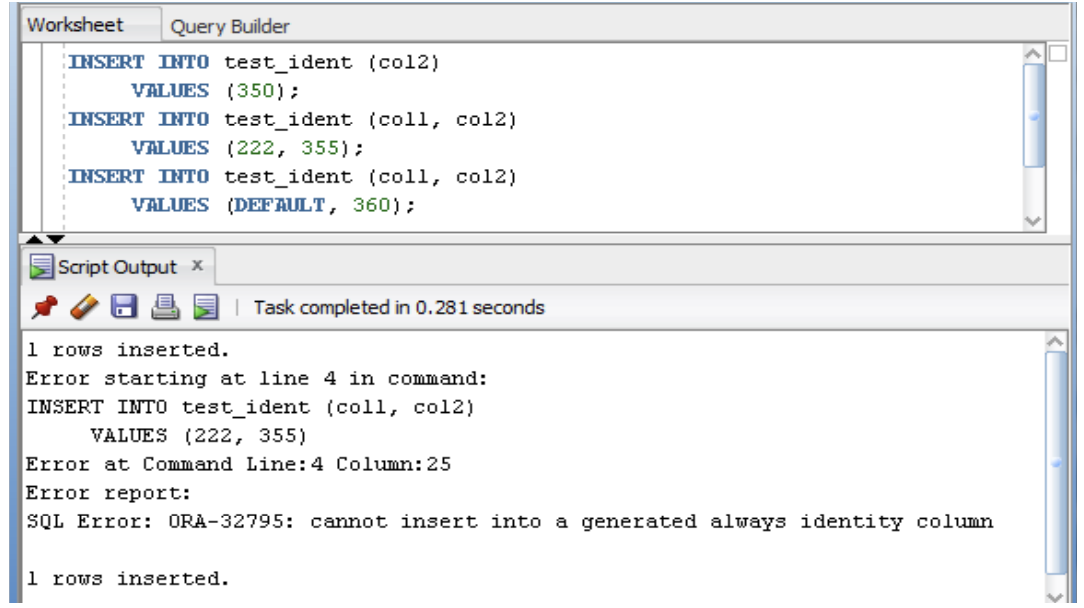
Indexes
- An index stores frequently referenced values and
ROWIDs - Can be based on one column, multiple columns, functions, or expressions
B-Tree Index
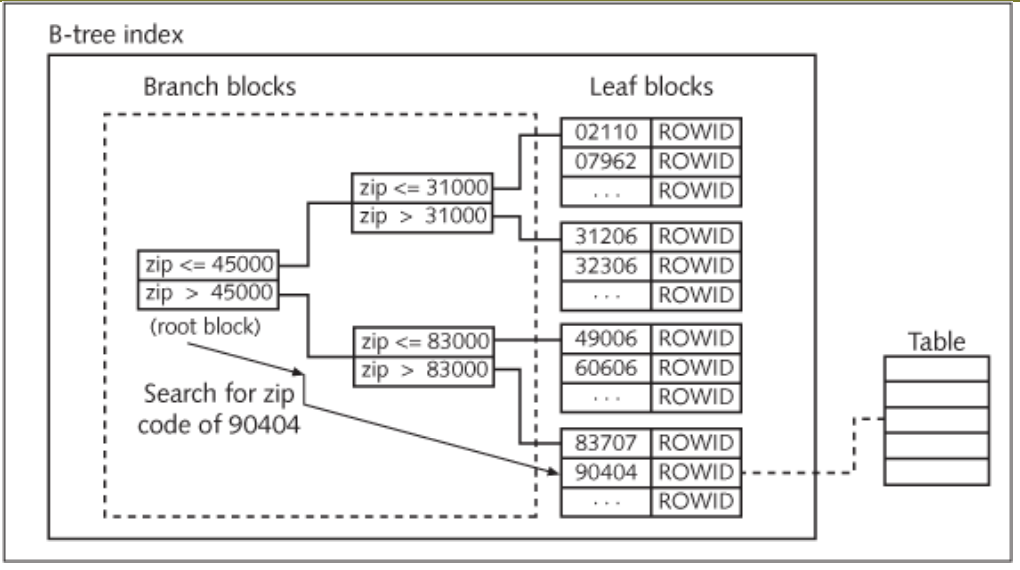
- Implicitly create an index by
PRIMARY KEYandUNIQUEconstraints - Explicitly create an index by using the
CREATE INDEXcommand
CREATE INDEX Command Examples
CREATE INDEX customers_zip_idx
ON customers (zip);
-- CREATE INDEX succeeded.
CREATE INDEX customer_name_idx
ON customers (lastname, firstname);
-- CREATE INDEX succeeded.
The Explain Plan
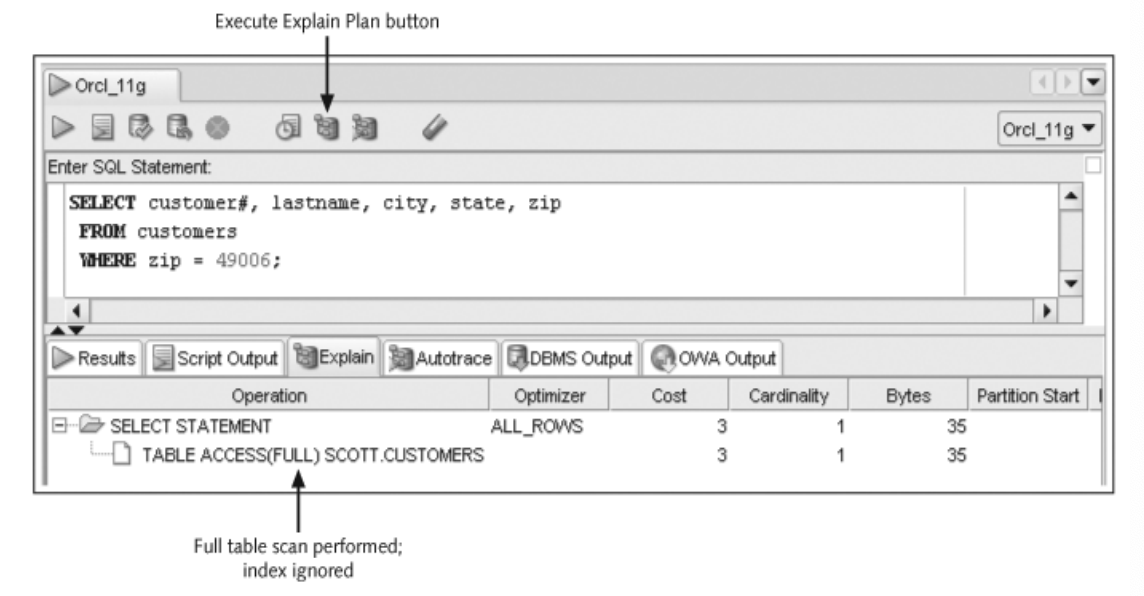
Bitmap Indexes
CREATE BITMAP INDEX customers_region_idx
ON customers (region);
-- CREATE BITMAP succeeded.
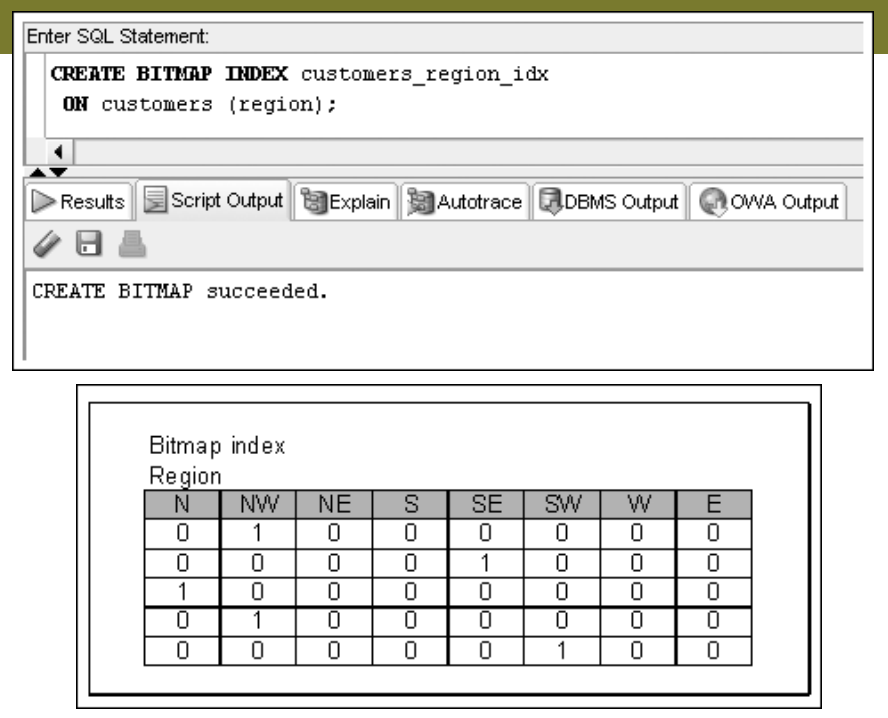
Function-Based Indexes
CREATE INDEX books_profit_idx
ON books (retail - cost);
-- CREATE INDEX succeeded.
CREATE INDEX orders_shipdate_idx
ON orders (NVL(shipdate, 'null'));
Index Organized Tables
- An IOT stores table contents in a B-Tree index structure
- Use the
ORGANIZATION INDEXoption in aCREATE TABLEstatement to build an IOT
CREATE TABLE books2
(ISBN VARCHAR2(10),
title VARCHAR2(30),
pubdate DATE,
pubID NUMBER(2),
cost NUMBER(5,2),
retail NUMBER(5,2),
category VARCHAR2(12),
CONSTRAINT books2_isbn_pk PRIMARY KEY(isbn))
ORGANIZATION INDEX;
Verifying an Index
- Use the
USER_INDEXESdata dictionary view to determine that the index exists - Use the
USER_IND_COLUMNSdata dictionary view to determine the column index information
SELECT table_name, index_name, index_type
FROM user_indexes
WHERE table_name = 'CUSTOMERS';
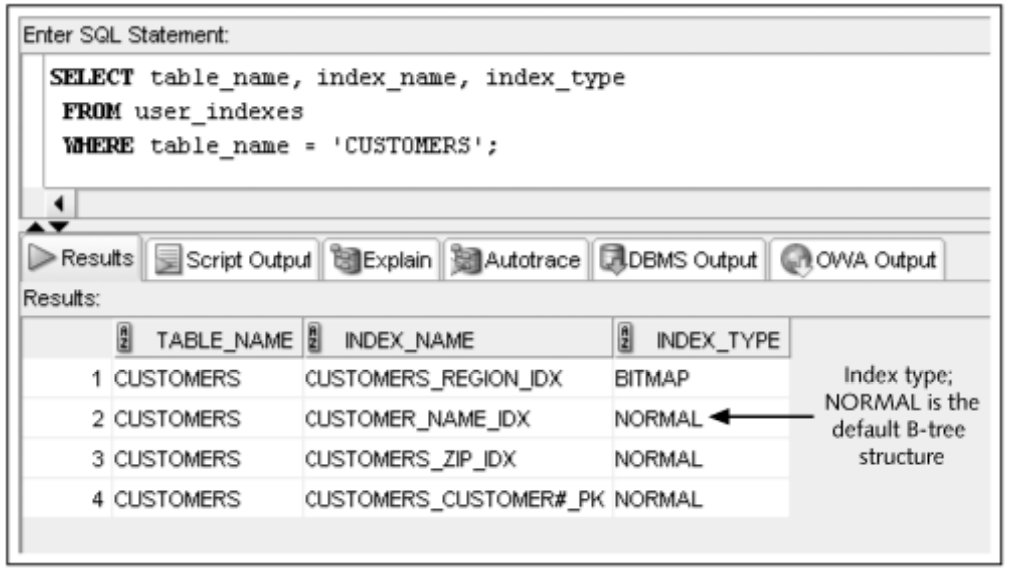
USER_IND_COLUMNS
SELECT table_name, index_name, column_name
FROM user_ind_columns
WHERE table_name = 'CUSTOMERS';
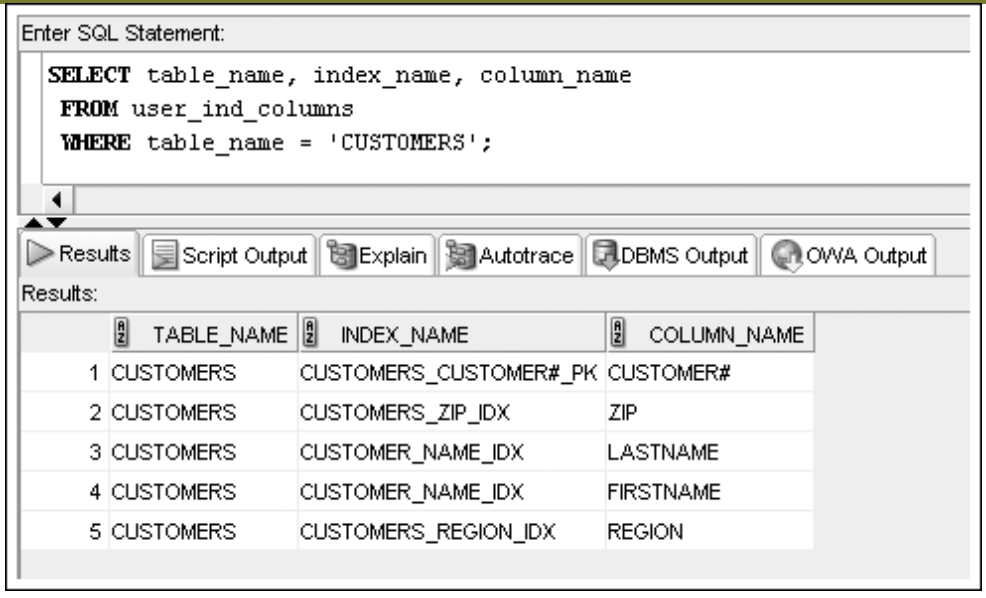
Removing an Index
- Use the
DROP INDEXcommand to remove an index
DROP INDEX books_profitcalc_idx;
-- DROP INDEX books_profitcalc_idx succeeded.
Synonyms
- Synonyms serve as permanent aliases for database objects
- Simplify object references
-
- Can be private or public
-
- Private synonyms are only available to the user who created them
-
- PUBLIC synonyms are available to all database users
CREATE SYNONYM Command Syntax
CREATE [PUBLIC] SYNONYM synonymname
FOR objectname;
CREATE SYNONYM Command
CREATE SYNONYM orderentry
FOR orders;
-- CREATE SYNONYM succeeded.
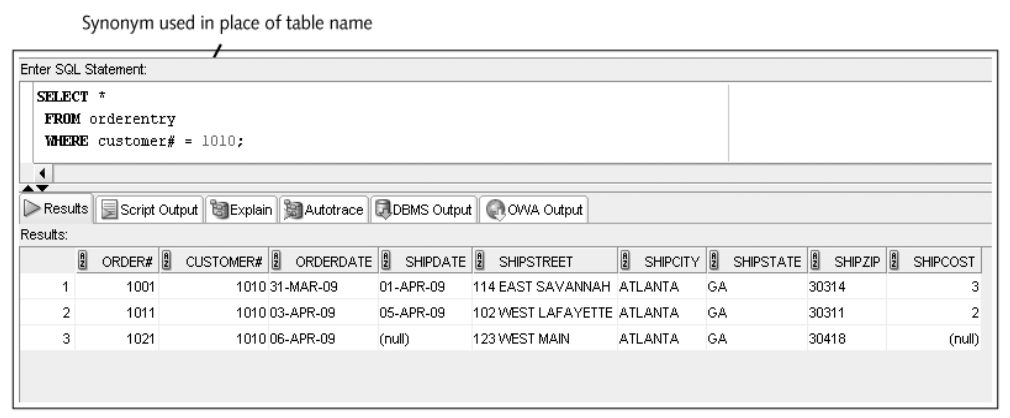
Deleting a SYNONYM
- A private synonym can be deleted by its owner
- A PUBLIC synonym can only be deleted by a user with DBA privileges
DROP [PUBLIC] SYNONYM synonymname;
DROP SYNONYM orderentry;
-- DROP SYNONYM orderentry succeeded.
Summary
- A sequence can be created to generate a series of integers
- The values generated by a sequence can be stored in any table
- A sequence is created with the CREATE SEQUENCE command
- Gaps in sequences might occur if the values are stored in various tables, if numbers are cached but not used, or if a rollback occurs
- A value is generated by using the NEXTVAL pseudocolumn
- The CURRVAL pseudocolumn is NULL until a value is generated by NEXTVAL
- The USER_OBJECTS data dictionary object can be used to confirm the existence of all schema objects
- The USER_SEQUENCES data dictionary object is used to view sequence settings
- A sequence may be set as a column DEFAULT value
- An identity column can be created to manage primary key population as an alternative to using sequences
- The ALTER SEQUENCE command is used to modify an existing sequence; the only settings that can’t be modified are the START WITH option and any option that would be invalid because of previously generated values
- The DUAL table is helpful for testing sequence value generation
- The DROP SEQUENCE command deletes an existing sequence
- An index can be created to speed up the query process
- DML operations are always slower when indexes exist
- Oracle 11g creates an index for PRIMARY KEY and UNIQUE constraints automatically
- An explicit index is created with the CREATE INDEX command
- An index can be used by Oracle 11g automatically if a query criterion or sort operation is based on a column or an expression used to create the index
- The two main structures for indexes are B-tree and bitmap
- The explain plan can verify whether an index is used in a query
- Function-based indexes are used to index an expression or the use of functions on a column or columns
- An index organized table is a table stored in a B-tree structure to combine the index and table into one database object
- Information about an index can be retrieved from the USER_INDEXES and USER_IND_COLUMNS views
- An index can be dropped with the DROP INDEX command
- An index can be renamed with the ALTER INDEX command
- Except for a name change, an index can’t be modified; it must be deleted and then re-created
- A synonym provides a permanent alias for a database object
- A public synonym is available to any database user
- A private synonym is available only to the user who created it
- A synonym is created by using the CREATE SYNONYM command
- A synonym is deleted by using the DROP SYNONYM command
- Only a user with DBA privileges can drop a public synonym

Leave a comment